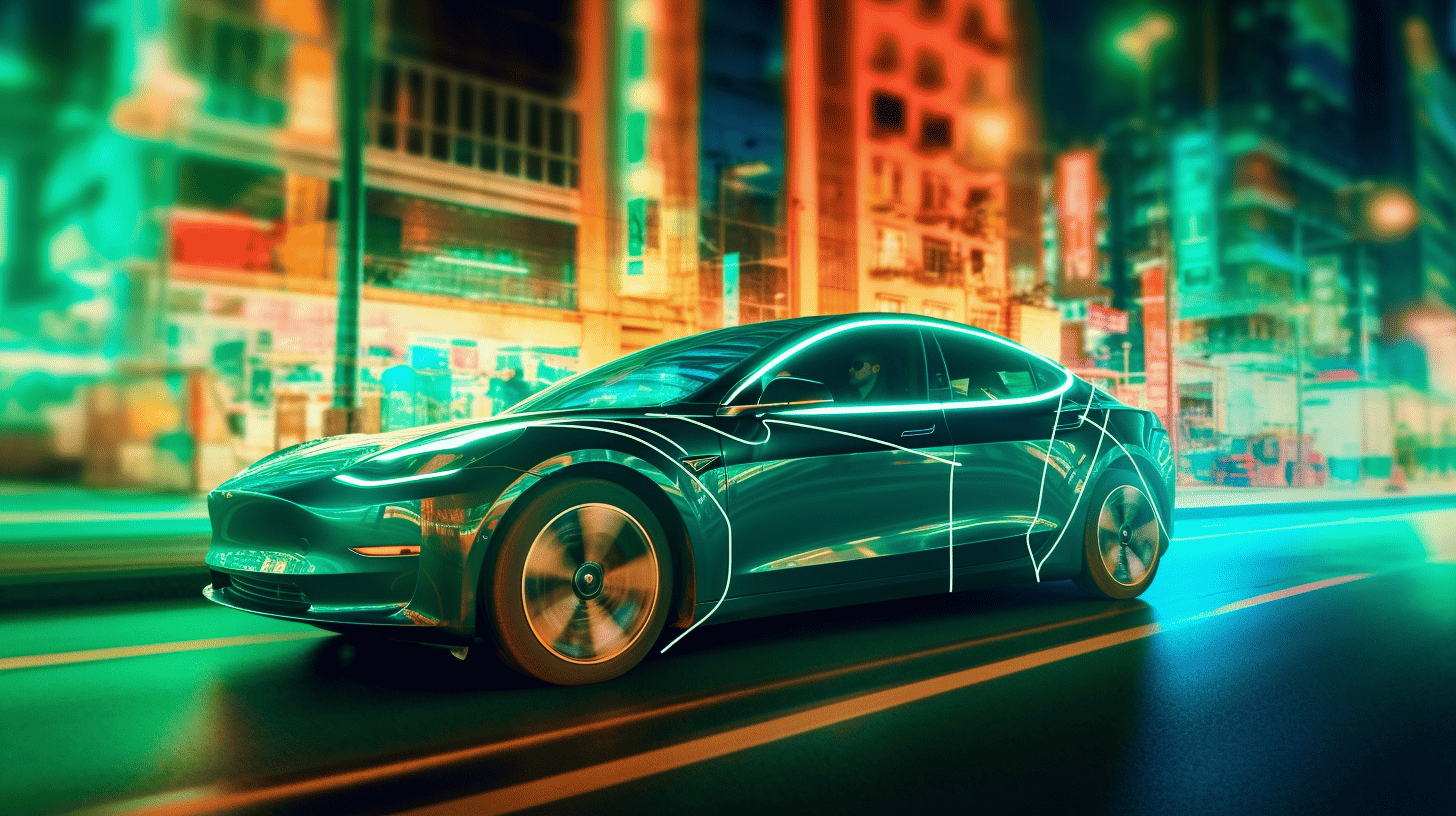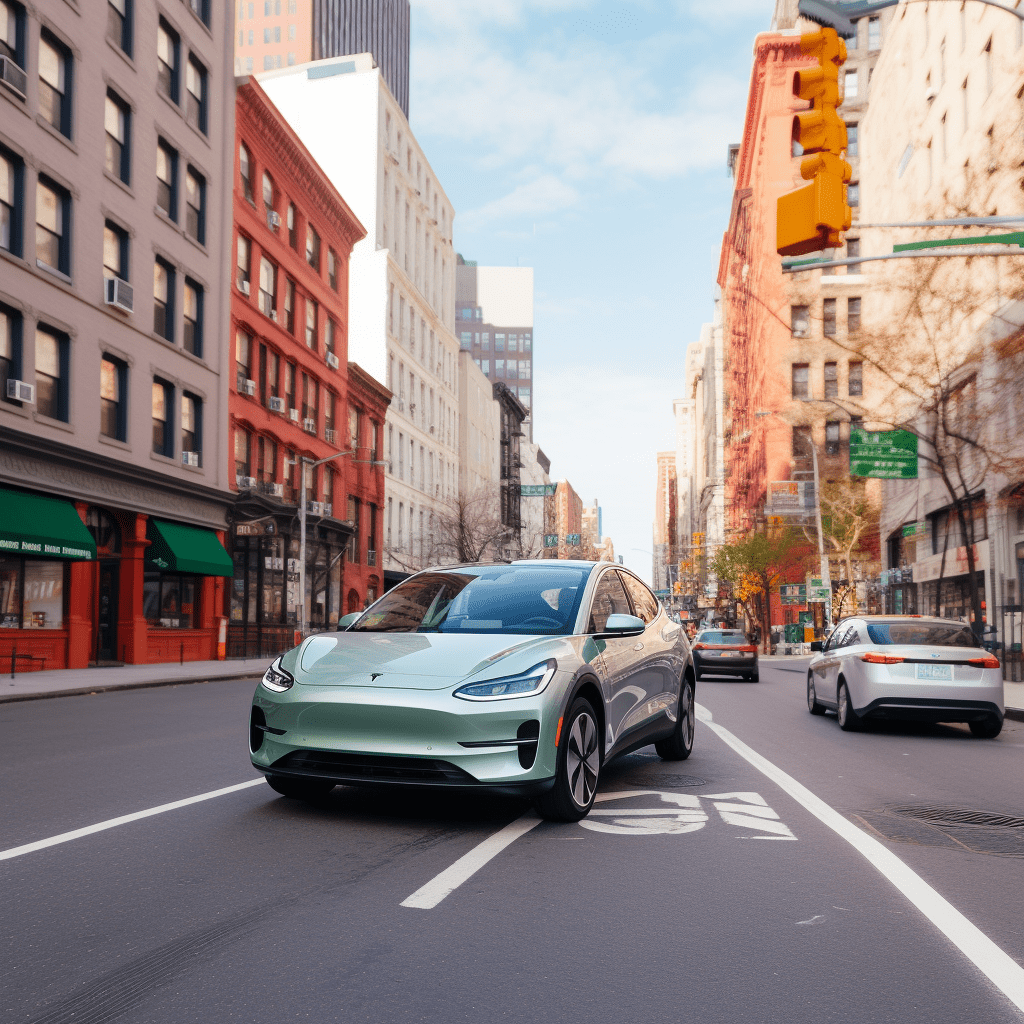Electric Vehicle
The Top 5 Most Affordable Electric Cars For Budget-Conscious Buyers

Looking for an electric vehicle without spending a fortune? Great news—there are multiple cost-effective choices out there. In this article, I will explore the five most economical models available in the market right now.
From luxury sedans to stylish hatchbacks, these cars offer plenty of features and performance without breaking the bank whether you’re a first-time EV buyer or just looking for something that won’t take too much out of your wallet, read on for more information about each model!
Electric vehicles (EVs) have come a long way in recent years. With advancements in battery technology and range capabilities combined with increasingly competitive pricing, it’s now easier than ever before to find a good quality EV at an affordable price point.
That said, some manufacturers still offer excellent value even when compared to their competitors, making them ideal choices for those who are shopping on a budget.
In this article, I will cover five great EVs that can provide reliable transportation while keeping your costs low. Not only will I outline which features make each car stand out from its peers, but I’ll also give my opinion as an automotive journalist on why they might be right for you, depending on your needs and wants. So keep reading to discover what could be the perfect fit within your budget!
Benefits Of Electric Cars
Electric cars are becoming more and more popular, with many budget-conscious buyers considering them for their next purchase. With a variety of benefits such as cost savings, fuel efficiency, emission reduction, and environmental protection, electric vehicles offer an incredible value proposition that is hard to beat.
When it comes to cost savings, the money you save on gas alone can make the upfront costs of an electric vehicle well worth the investment.
For instance, according to Consumer Reports data from 2019, drivers in California saved $1,000 annually on average by switching from a gasoline-powered car to an electric one. That number jumps up even higher if you live in states like Texas or Illinois where electricity prices are lower than those in California.

Another great benefit is being kinder to the environment. Electric cars have zero tailpipe emissions and are therefore much better for air quality compared to traditional petrol-driven vehicles.
In addition, they use no oil or other fluids, so less waste is produced during maintenance compared to petrol-powered cars.
The fact that electric cars require significantly fewer moving parts also makes them incredibly efficient; some models get over 200 miles per charge!
This eliminates trips to the pump altogether while reducing overall operating costs which helps offset any differences between fuel and energy expenses throughout the ownership of your vehicle. Now let’s take a look at understanding how much it will actually cost to own an electric car…
Understanding Electric Car Costs
When it comes to electric car costs, budget-conscious buyers have a lot to consider. Understanding the total cost of an electric car is not always straightforward and requires some research in order to make smart decisions when buying one. So what should you look out for?
To start with, price comparisons are essential. Compare prices between different models and even brands as there will be variations. It’s also worth looking into any special offers or discounts that might apply to certain vehicles.
Additionally, take factors such as running costs into account; although electric cars may require less maintenance than their gasoline counterparts, they still require energy (electricity) which needs to be taken into consideration too.
For those who want to save further on their purchase, there are various tips and tricks available online for budgeting for an electric car. For instance, researching local grants or tax incentives can help reduce the overall cost of ownership significantly – something well worth considering before committing to a purchase.
Electric cars offer great value for money when factoring in their lifespan and fuel savings over time – so getting your head around up-front costs is certainly worth it! With this knowledge under your belt, you’ll be better equipped when making decisions about the affordability of electric cars down the line.
Factors Impacting The Affordability Of Electric Cars
Now that we understand the basic costs associated with electric cars, let’s look at some of the factors influencing their affordability. For those on a budget, range and battery life are likely to be two major considerations when choosing an electric car.
Many economy models have shorter ranges than their pricier counterparts and may need more frequent charging – something which could add up if you’re not near a charging station or don’t own one yourself.
It is worth looking into maintenance costs too; while these tend to be relatively low for electric vehicles compared to traditional petrol-powered cars, they can still vary depending on the model you choose. As well as factoring in any additional charges like registration fees or insurance premiums, it pays to keep an eye out for any available tax incentives or other discounts.
These can make a significant difference in reducing the overall cost of buying an EV and should definitely be taken advantage of where possible.
Comparing available models and prices is arguably one of the most important steps when searching for your ideal affordable electric vehicle. By researching different makes and models thoroughly before making a decision, you’ll be able to ensure that you get exactly what you need without breaking the bank!
Comparing Available Models And Prices
When it comes to electric car models, there are a lot of options out there for budget-conscious buyers. It’s important to compare prices and features when considering which one is the right fit. Here we’ll look at five of the most affordable cars on the market today.
The Hyundai Kona Electric stands out as an excellent value. It has a range of up to 258 miles per charge and can be had for around $37,000 with federal tax credits applied.
Its interior also offers plenty of space for passengers and cargo alike, making it a great choice for those who need something practical but don’t want to break the bank.
Another option that won’t blow your budget is the Nissan Leaf Plus S. This model has a range of up to 226 miles per charge and starts around $32,500 after incentives have been applied. With its sleek design and modern tech features, it’s sure to turn heads while being easy on your wallet.
For those looking for an even more cost-effective solution, the Chevrolet Bolt EV may be just what you’re looking for. Starting at around $31,000 after incentives, this car still packs quite a punch with 259 miles of range per charge.
Plus with its roomy interior and an impressive array of safety features, you can feel confident in knowing you made a smart purchase without sacrificing quality or performance.
So if you’re shopping around for an electric car on a budget, these five models offer some great deals without compromising on quality or performance.
Now let’s take a look at how far each vehicle can go on a single charge – an important factor when choosing between available models – as well as their battery life considerations before making your final decision.
Range And Battery Life Considerations
Range and battery life are two of the most important considerations when shopping for an electric car. Without adequate range, a vehicle can be rendered essentially useless for long-distance driving. Fortunately, with advances in battery technology, many budget-friendly vehicles now offer ranges on par with some of their more expensive counterparts.
When assessing a vehicle’s range capabilities, it is important to consider its battery capacity and how much power is needed to propel the car along different terrain and at varying speeds.
Many cars advertise impressive range numbers based off of ideal conditions such as flat roads or low-speed travel. It’s important to take into account that these figures may vary significantly in real-world scenarios.
Ultimately, if you plan on using your electric car for longer trips or highway commutes, make sure you do your homework before making a purchase decision. Make sure a model has enough range to cover all your needs without running out of juice prematurely.
Charging Stations And Availability In Your Area
Powerful possibilities for purchasers of electric cars are popping up all over. For budget-conscious buyers, it’s important to consider the charging availability in their area before making a purchase decision. With electric car charging stations becoming more commonplace and accessible, local availability is now easier than ever to check on.
For starters, many cities are offering incentives such as free parking spots or discounted rates at public chargers that can make owning an electric vehicle cost-effective.
On top of that, there are also numerous private companies setting up powerful charging networks across the country with flexible payment plans. This means you could charge your car right outside your home without paying anything extra beyond the initial cost of installation.
No matter where you live, researching options for electric car charging availability should be part of any serious buyer’s process when considering an EV purchase.
And with so many advantages available to those who go green, why not take advantage? Transitioning into the subsequent section about maintenance costs for electric vehicles may seem like a daunting task but its one worth taking on if you want to get behind the wheel of an economical and eco-friendly ride.
Maintenance Costs For Electric Vehicles
Maintenance costs for electric vehicles are significantly lower than those of traditional gasoline-powered cars. This is because electric cars don’t require oil changes or regular tune-ups, which can be costly and time-consuming.
Plus, the brakes on an electric car last much longer due to regenerative braking, where energy is stored in the battery when you slow down or stop. Electric cars also have fewer moving parts overall compared to their gas-powered counterparts, so they’re less likely to need expensive repairs over time.
It’s important to note that although electric vehicles may not need as many repairs as a traditional vehicle, they still require some basic maintenance such as replacing wiper blades and tires, checking fluid levels, and keeping the batteries charged.
However, since most EV owners charge their vehicles at home overnight, this isn’t usually an issue. And if something does go wrong with your EV, specialized mechanics who specialize in electric cars are becoming more common these days so repair costs shouldn’t be too high either.
Overall, it’s clear that owning an electric car is cheaper than running a conventional one in terms of maintenance costs alone – making them a great investment for budget-conscious buyers looking for long term savings. Now let’s look at how tax incentives might help reduce the cost of purchasing an electric car even further…
Tax Incentives For Purchasing An Electric Car
Did you know that electric car tax incentives can save drivers up to $7,500? This alone is a compelling reason for budget-conscious buyers to consider making the switch from traditional gasoline cars to electric vehicles.
As governments across the globe strive to reduce their carbon footprint and promote renewable energy sources, generous tax breaks are being offered in many countries.
Electric car tax breaks include federal or state income tax credits which may be applied when buying a new EV. In some countries, electric vehicles also qualify for local property taxes reductions or exemptions as well as reduced registration fees.
Furthermore, there could be other incentives such as free parking access or use of lanes restricted only for EVs on congested roads. For instance, in France all-electric cars enjoy unlimited free parking in Paris city center.
In addition to these electric vehicle tax credits, some employers offer subsidies and deductions for employees who purchase an EV – another way to help make it more affordable.
These benefits vary widely by country so individuals should research what’s available before deciding whether to go electric or not. All these combined provide great relief when purchasing an electric car but don’t forget insurance considerations—the next step in owning your own eco-friendly ride!
Insurance Considerations
Regarding electric car insurance, budget-conscious buyers should compare rates and research coverage options. Insurance companies are beginning to offer specialized policies for electric cars that cover the cost of repairs due to mechanical failure as well as provide liability protection in case of an accident.
It’s important to shop around and ask questions when considering any auto insurance policy; this is especially true if you’re looking at a dedicated electric car coverage plan.
It’s also worth noting that some insurers may charge higher premiums for electric vehicles since they often have more expensive parts than their gas-powered counterparts. Depending on your driving habits and other factors, these costs could be offset by savings on fuel expenses over time so don’t let sticker shock deter you from taking a closer look at potential plans.
Ultimately, finding the right balance between protection and affordability can help ensure peace of mind while also helping keep your wallet happy. Now let’s take a look at financing options available to budget-conscious buyers interested in an electric vehicle purchase.
Financing Options
Regarding budget-conscious buyers, electric cars can be a great option. Fortunately, plenty of financing options are available for those looking to purchase an electric car. From electric car loans to electric car leasing and even electric car payment plans, buyer have plenty of choices when it comes to finding the right financial solution for their needs.
Electric car loans offer potential buyers the ability to pay off their vehicle in installments over time. This is usually done through a bank or other private lender who will approve the loan based on creditworthiness and other factors.
Buyers should shop around carefully for the best interest rate before settling on one particular lender.
Leasing an electric car is also becoming increasingly popular among budget-conscious buyers due to its flexibility and affordability. Leases tend to have lower monthly payments than traditional auto loans because they require less upfront money down toward the cost of the vehicle.
Additionally, some leases come with additional benefits such as free maintenance and roadside assistance packages that make them more attractive than buying outright.
Finally, many manufacturers offer special financing programs tailored explicitly toward purchasing an electric car. These programs may provide incentives like zero percent APR rates or longer repayment terms which can reduce the overall cost of ownership significantly.
It’s important to research these offers thoroughly prior to making any decisions, however, as they typically contain restrictive clauses that could potentially end up costing you more in the long run if not properly understood beforehand.
Frequently Asked Questions
What Is The Average Price Of An Electric Car?
Electric cars are becoming increasingly popular, with their lower running costs and environmental benefits.
But what is the average price of an electric car? Well, it really depends on your budget – electric car prices range from around $20k to upwards of $70k depending on make and model. They can also be more expensive than traditional gas-powered vehicles in terms of initial cost. To give you a better idea about the cost comparison for electric cars, here’s a breakdown of the pricing:
- An entry level electric vehicle could start at around $20k-$30k
- Mid-level models typically fall between $35k-$50k
- High-end options generally begin at over $50k
- Luxury models may exceed $75K
When shopping for an electric car it’s important to research all available models within your budget before making any decisions. While there are great deals, some luxury brands like Tesla come with a premium price tag.
It pays to shop around and compare different makes and models, as well as look for discounts or special offers that might help bring down the overall cost of ownership. Many manufacturers offer incentives that can reduce the sticker price significantly when purchasing an electric car so keep this in mind during your search.
Overall, electric cars offer considerable savings once they are purchased but the higher upfront costs compared to petrol-powered alternatives should still be taken into consideration when deciding which type of vehicle is right for you.
With careful research and planning, you’ll be able to find a great deal on an affordable yet efficient electric vehicle that fits both your lifestyle and budget needs.
How Long Does It Take To Charge An Electric Car?
Charging an electric car can be complex, depending on the model and battery capacity. While some models offer rapid charging that can take only minutes to complete, others require much longer charge times before they are ready for use.
Understanding how long it takes to charge your electric vehicle is important when planning trips or ensuring you don’t run out of power while driving.
Electric vehicles come with their own unique type of chargers which must be plugged into specialized outlets known as charging stations. The amount of time needed to charge depends largely on the size of your electric car’s battery and the speed at which it charges.
Rapid chargers, such as those available in public spaces like shopping centers, allow users to fill up quickly – often within around 30 minutes – but this isn’t always possible if you’re relying on home charging methods.
On average, most electric cars will need between four to five hours from empty to full using slow-chargers found in garages or other locations where access may not be so convenient. Some more advanced models support faster speeds, allowing drivers to get back up and running quicker than ever before; however this feature does come at an extra cost.
Ultimately, it all comes down to understanding your car’s capabilities and being prepared for any eventuality during longer journeys by knowing exactly how long it takes for your car’s battery to recharge fully.
Are Electric Cars More Reliable Than Gas-Powered Cars?
Regarding electric cars, one of the most pressing questions for budget-conscious buyers is their reliability compared to gas-powered vehicles. Are electric cars really more reliable than gasoline-powered models? Let’s take a look at the facts and see what we can determine.
First, let’s talk about how durable electric cars are compared to traditional fuel sources. Studies have shown that electric car components typically last longer than those found on gas-powered cars because they don’t require frequent maintenance or regular oil changes.
Furthermore, since battery packs don’t move around like combustion engines, they tend to experience less wear over time, leading to increased longevity. On the other hand, gasoline engines often suffer from mechanical problems due to their complex inner workings, resulting in decreased durability over time.
Looking at overall reliability between these two types of vehicles is even more telling. In general, electric cars have fewer moving parts and are therefore inherently simpler when it comes to operation – this translates into fewer breakdowns and less need for repairs down the road. Additionally, there are no spark plugs or cylinders, which further minimizes potential issues with an EV versus a standard gasoline engine vehicle.
When you factor in reduced pollution levels as well as lower operating costs for EVs due to not having to pay for fossil fuels anymore, it becomes clear why many people consider them far superior options when looking for long-term dependability out of any automobile.
So while both electricity and gas still remain viable sources of power for automobiles today, evidence shows that electric cars offer greater reliability and durability than their counterparts with internal combustion engines – making them excellent choices for budget-conscious buyers who want peace of mind without breaking the bank.
Is There A Difference In Performance Between Electric And Gas-Powered Cars?
As we enter into the electric car revolution, it’s important to understand what sets them apart from their gas-powered counterparts. When it comes to performance, is there a difference? Let’s explore this question in more detail.
When comparing electric and gas-powered cars side by side, many assume that electric vehicles will be slower and have less power than traditional gasoline engines. But contrary to popular belief, modern electric motors can actually deliver higher torque at lower speeds than internal combustion engines, which means they can go from 0-60 faster!
Additionally, electric cars don’t need as much maintenance since they lack an exhaust system or oil filter and use fewer parts overall. In terms of environmental impact, because these cars are powered by clean electricity instead of burning fossil fuels like petrol or diesel, driving a zero-emissions vehicle helps reduce greenhouse gases significantly.
So when it comes down to it – how do these two types of cars compare in terms of performance? Well both have their strengths and weaknesses depending on your needs but generally speaking, most experts agree that electric models offer superior acceleration and handling due to the instant torque delivery provided by the motor while gas-powered cars provide better range and top speed potential thanks to their larger fuel tanks.
Ultimately though, the choice between an EV or ICE (internal combustion engine) vehicle comes down to personal preference as each has its advantages and disadvantages for different applications.
No matter which type you choose though, one thing is certain: having access to reliable transportation options that prioritize efficiency and sustainability is essential for our planet’s future health – so make sure you take some time to research before making any decisions about your next ride!
Are Electric Cars More Expensive To Insure Than Gas-Powered Cars?
When it comes to buying a car, one of the most important factors for budget-conscious buyers is the cost of insurance. So when comparing electric and gas-powered vehicles, are there any differences in insurance costs?
The answer really depends on the type of coverage you’re looking for. Generally speaking, electric car insurance tends to be more expensive than that of its gas-powered counterparts. This is because insurers consider electric cars to have higher repair costs due to their advanced components and battery packs.
However, opt for comprehensive coverage or additional features such as roadside assistance. Your rates may actually be lower with an electric vehicle compared to a gas-powered one.
It’s also worth noting that some states offer discounts on electric car insurance premiums based on how much fuel they save over conventional gasoline engines.
Additionally, certain companies specialize in insuring electric vehicles and can provide customized plans tailored specifically to your needs. That said, it’s always wise to compare different policies from multiple providers before making a final decision.
No matter what type of car you choose for yourself – electric or gas-powered – understanding the various aspects of automobile insurance is essential to ensure you get the best deal possible. To make sure you don’t miss out on any potential savings opportunities, take time to do your research and shop around for competitive quotes from different carriers when evaluating your options for electric vehicle insurance or gas car insurance comparison.
Conclusion
To wrap up, electric cars are becoming increasingly popular for budget-conscious buyers who want to save money in the long run. While an initial cost is associated with purchasing and charging an electric car, its lower running costs make up for this expenditure. Furthermore, electric cars offer reliable performance, and better fuel efficiency than gas-powered vehicles and may even be cheaper to insure.
The top five most affordable electric cars are the Nissan Leaf, BMW i3, Kia Soul EV, Chevrolet Bolt EV and Hyundai Ioniq Electric. Each of these models offers a good range of features at a great price point. What’s more – they all come equipped with advanced safety technology that ensures you have peace of mind when driving your new car.
In conclusion, then, if you’re looking for an eco-friendly alternative to gasoline-powered vehicles without breaking the bank, one of these five electric cars could be a perfect fit for your needs! Plus – by embracing green energy solutions such as electric cars we can help reduce our carbon footprint while saving money in the process; truly a win-win situation!
Olivia’s writing is not only informative but also inspiring. She has a knack for telling stories that capture the essence of cycling and the joy it brings to people’s lives. Her writing has been praised by readers and industry experts alike for its clarity, depth, and authenticity.
In addition to her writing, Olivia is also an avid cyclist. She enjoys exploring new trails and routes and has participated in several cycling events and races. Her first-hand experience with cycling gives her a unique perspective on the sport, reflected in her writing.
Overall, Olivia is a talented writer passionate about cycling and dedicated to producing high-quality content for FlatironBike. Her contributions to the magazine have helped make it a go-to source for cycling enthusiasts worldwide.
Electric Vehicle
Electric Cars Less Expensive

Hello electric vehicle fans! I’ve got some thrilling updates for you. Electric vehicles are increasingly becoming more affordable, making them more accessible to everyone!
In this article, we’ll explore the reasons why electric vehicles have become increasingly affordable in recent years. We’ll also discuss how these cost savings can benefit drivers who want to make a positive environmental impact.
So buckle up and let’s take a closer look at the economics of electric cars!
Battery Technology Advances
It’s amazing how far electric car technology has come in such a short time! It almost feels like just yesterday that the idea of cars running on electricity was nothing more than a dream, but now not only are they becoming a reality, but they’re also getting cheaper.
Solar charging and ride sharing have made it possible to drive an electric vehicle without breaking the bank, providing people with an affordable way to reduce their environmental impact while still enjoying the luxury of owning a car.
Government incentives have been critical in helping make electric vehicles more accessible for everyone. Many countries around the world offer generous tax credits or other financial support to encourage people to switch from gas-powered cars to electric ones. In some places, there are even programs offering free solar charging stations so drivers can keep their cars charged up wherever they go.
These advances have significantly lowered the cost of ownership for electric vehicles compared to traditional gasoline models. With prices dropping rapidly, many consumers are finding that purchasing an EV is actually less expensive than buying a standard automobile – something that seemed impossible just a few years ago!
By taking advantage of government incentives and exploring options like solar charging and ride sharing, anyone can join the revolution and help create a greener future for us all.
Government Incentives
Electric cars are becoming increasingly popular, and for a good reason. Not only do they provide an alternative to traditional fuels, but they also help reduce emissions standards, making them more environmentally friendly than ever before. Plus, their prices are now coming down in cost, making them far more accessible to everyday people that want the convenience of an electric car without having to break the bank.
Government incentives have helped push this trend even further by offering rebates and tax credits to those who choose to invest in electric vehicles. This has made it easier than ever for buyers to purchase these cars with less financial strain on their pockets. And while there is still work to be done when it comes to bringing down costs, government incentives will continue to play a vital role in the future of green transportation initiatives.
The improvements in production processes over time have also been instrumental in helping bring down costs associated with electric cars. As new technologies become available, manufacturers can make better use of existing resources and create new products at reduced rates. This helps keep the overall price tag low so that consumers can reap the benefits of owning a modern electric vehicle without paying too much out-of-pocket expense.
Overall, electric cars offer great potential for sustainability and environmental protection due largely in part to reduced fuel consumption as well as lower emissions standards compared to gas powered vehicles. With governments encouraging investment through various incentives and manufacturing advancements improving efficiency every day, electric cars are sure to become even more affordable in the near future – providing greater access for drivers around the world looking to go green.
Improvements In Production
It’s no secret that electric vehicles are becoming more and more popular. In fact, according to the U.S. Department of Energy, sales of plug-in cars have ‘quadrupled from 2014 to 2018.’
With government incentives making EVs even more affordable, it’s no wonder people are clamoring for them! The improvements in production technology have made a big difference too.
Not only are alternative fuels being used in many new models, but autonomous driving capabilities make it easier than ever to get around without relying on traditional gas-powered engines. Plus, with lower emissions requirements, there’s less impact on the environment when driving an EV.
As if all this weren’t enough reason to consider buying an electric vehicle, they also offer significant savings in terms of maintenance costs over gasoline or diesel powered vehicles. Without oil changes and other scheduled services required by combustion engines, drivers can look forward to spending less money keeping their car running at optimal performance levels.
And with increasing availability of charging stations across the country, going electric has never been easier!
Lower Maintenance Costs
One of the best parts about owning an electric car is the reduced maintenance costs. Not only do these cars require less frequent oil changes, but they also feature optimized efficiency that greatly reduces wear and tear on the engine. This means you can get more miles out of your vehicle without having to make costly repairs or replacements for years down the road.
Plus, with cost effective solutions such as regenerative braking technology, you can save even more money in fuel costs over time.
At first glance, purchasing an electric car may seem expensive compared to a traditional gas-powered vehicle. However, when you factor in all of the long-term savings associated with electric vehicles — including lower maintenance costs — it’s easy to see why so many people are choosing this option instead.
Furthermore, with advances in battery technology making charging faster and easier than ever before, there’s no reason not to explore the possibilities of electric mobility today.
Beyond just reducing maintenance expenses, investing in an electric vehicle could lead to significant savings on insurance premiums as well. Since insurers consider them safer than conventional cars due their advanced safety features like automatic emergency brakes and lane departure warnings, rates tend to be much lower than those charged for gas-powered models.
So if you’re looking for a way to save money and reduce your carbon footprint at the same time, then going green with an EV might be exactly what you need.
Reduced Insurance Rates
It was almost too good to be true: electric cars becoming more affordable! But that’s not the only financial benefit of switching over to an electric vehicle.
Not only are they cheaper, but insurance rates for EV drivers tend to be lower as well.
As you can imagine, fuel efficiency is a major factor in determining how much you pay for auto insurance each year. Electric vehicles use far less gasoline than traditional combustion engines and cause significantly fewer emissions, which means they’re seen as being safer on the roads. This results in lower premiums if you choose to drive an EV instead of a gas-powered car.
Alternative fuels have also made their way into transportation, providing even more options when it comes time to pick out your next set of wheels. With so many advantages in terms of cost and sustainability, its no wonder why people are turning towards eco-friendly alternatives like EVs – making them the perfect choice for those who value both selflessness and savings.
Moving onto charging stations, we find yet another perk…
Increased Charging Stations
Electric cars have become much more accessible to the average consumer in recent years, thanks to advancements in technology that have made them less expensive and much easier on the wallet. What’s even better is that they are becoming increasingly efficient with each new iteration released by manufacturers.
Smart charging has been a key player in this evolution – it helps electric vehicles get the most out of their fuel efficiency as well as extend range so drivers can go further for longer. Here are some impressive features you’ll find with smart charging:
- Automatically optimizes charge levels when plugged into an outlet
- Predicts current energy demand and adjusts accordingly
- Allows automakers to upgrade software remotely
- Detects power interruptions and switches from main grid power source
- Enhances battery life over time
Smart charging isn’t just about convenience; it also provides environmental benefits like reducing emissions associated with gas-powered automobiles. With all these great features, no wonder why electric cars remain such a popular choice among consumers today!
Tax Credits And Rebates
Exploring alternatives to traditional gasoline-powered vehicles has never been more exciting. With electric cars becoming increasingly cost effective, governments and businesses are joining forces to incentivize the movement away from fossil fuels towards renewable energy sources such as wind, solar, and hydroelectric power. Tax credits and rebates have become a prominent feature in this effort, allowing consumers access to even greater savings when purchasing an electric vehicle.
The federal government offers tax incentives for those who opt for cleaner forms of transportation such as electric vehicles or hybrids. In some states there’s also state level incentives available that can result in substantial savings on car purchases.
For example, California currently provides up to $7,500 off the purchase price of an eligible zero emissions vehicle (ZEV), while New York’s Drive Clean Rebate Program gives residents up to $2,000 off their new ZEV purchase.
These tax benefits make owning an electric car a much more attractive proposition for many buyers than it used to be. Fears about being stuck with expensive fueling costs or high maintenance bills evaporate when considering models like Chevrolet Bolt EV which offer low environmental impact and long term money saving potential through reduced fuel costs over the lifetime of the car.
With these sorts of economic advantages now firmly established within reach of most consumers, inexpensive leasing options have opened up possibilities for many drivers who might otherwise struggle to own a vehicle outright.
Inexpensive Leasing Options
Now that you know the basics of how tax credits and rebates can help make electric cars more affordable, let’s talk about some other ways to get behind the wheel without breaking the bank.
Inexpensive leasing options are a great way to enjoy all the benefits of owning an EV without committing fully to buying one outright.
Leasing is like renting a car for a predetermined period of time with fixed payments each month—but it also comes with additional advantages:
- Affordable financing – Lease payments may be lower than what you’d pay when taking out a loan on a new or used vehicle.
- No major up-front investment – You don’t need to worry about putting down thousands of dollars in cash before getting started.
- Access to charging infrastructure – Most leases come bundled with access to public chargers or home installation services at discounted rates so you’ll have everything you need while driving your EV around town (and beyond).
Plus, there are long-term cost savings associated with EVs that go hand-in-hand with inexpensive lease deals, such as reduced maintenance costs due to fewer moving parts and cheaper fuel prices compared to traditional gasoline vehicles over time.
Long-Term Cost Savings
I’m sure you’ve heard about the cost savings of electric cars – and it’s true, they are less expensive to run than their fuel-powered counterparts. But that doesn’t even begin to scratch the surface when it comes to long-term savings.
Electric vehicles offer faster charging times, greater fuel efficiency, and lower maintenance costs over time.
For starters, charging times for electric cars can be much faster than gasoline powered ones. Depending on your particular car model, some EVs will charge in as little as 15 minutes! That means no more waiting around at the gas station filling up with petrol every few days. This results in significant financial savings because you’re not paying for fuel or associated fees each time there is a stop for refueling.
Plus, EV drivers benefit from higher miles per gallon equivalent ratings (MPGe). An average electric car offers 80-90 MPGe compared to only 30 MPG from most conventional vehicles. With an EV you’ll spend fewer dollars overall on energy consumption saving money month after month without sacrificing performance or power.
The bottom line? Investing in an electric vehicle today could lead to tremendous future savings – both financially and environmentally!
Reduced Environmental Impact
I’m so excited about electric cars becoming more affordable and accessible! With the reduced cost of owning an electric car, we can make a real impact on reducing carbon emissions and air pollution.
It’s incredibly important to make this change now, before the effects of climate change become even worse.
I’m confident that with the right incentive, electric car ownership could become the norm in the near future!
Decreased Carbon Emissions
Hey everyone, I’m here to talk about the impact electric vehicles have on reducing carbon emissions!
It’s incredible how much of an effect they can have in such a short time. Not only does driving an EV reduce fuel consumption and save money, but it also reduces our overall environmental impact with zero emissions from traditional gasoline-powered engines.
Plus, EVs are powered by renewable energy sources like solar or wind power. That means even more reduction in your carbon footprint since you’re using clean energy instead of fossil fuels that produce toxic fumes into the air.
EV ownership is becoming increasingly popular as people become aware of their many benefits – not just financially but for the environment too. So if you’re looking for a way to contribute to making a positive difference in the world around us, consider switching to an electric car today!
Reduced Air Pollution
Switching to an electric car is not only great for reducing fuel costs, but also for improving air quality. Driving a zero-emission EV means there are no harmful fumes being released into the atmosphere. This helps reduce levels of dangerous pollutants like carbon monoxide and nitrogen dioxide that can be damaging to our health.
Not to mention, cleaner emissions mean fewer greenhouse gases in the environment which can help slow down global warming. EVs offer significant fuel savings compared to gasoline powered cars too. Since they don’t require fossil fuels and instead use renewable energy sources like solar or wind power, you can save money on gas while helping protect the planet at the same time – it really is a win-win situation!
Plus, many governments provide incentives such as tax credits or rebates when buying an EV so it’s even more affordable than before. By making the switch today, we’re all taking part in creating a healthier future for generations to come. EVs help us contribute positively towards addressing climate change by reducing air pollution and cutting back on emissions from traditional engines – so let’s do our part now!
Enhanced Features
Electric cars are becoming more and more accessible to folks who may not have had the chance before. The cost of owning one has become substantially lower, making it an attractive option for many people. With a range of accessibility options available, electric vehicles are now bringing design innovations to the table too.
From automatic braking systems that help you avoid collisions with other cars or pedestrians, to battery technology that makes long-distance travel possible – these advancements make electric vehicles much safer and more reliable than ever before. The performance of electric vehicles continues to improve as well. We’re seeing faster acceleration times, improved handling, and quieter rides due to advanced soundproofing techniques being implemented on newer models.
And let’s not forget about those sleek designs! Electric car manufacturers are constantly working to make their products look most visually appealing while maintaining safety standards at the same time. For many individuals, driving an electric vehicle is quickly becoming a reality thanks to all the improvements in this area over recent years.
As we move into a new era of clean energy solutions, there’s no telling how far electric vehicles will go – both literally and figuratively speaking! Range can only increase from here; so let’s explore what increased range means for drivers next.
Increased Range
It’s no secret that electric cars have become more affordable in recent years, and the latest statistics back this up. According to a survey conducted by the Electric Vehicle Association, 58% of respondents said their electric car was less expensive than buying a traditional gas-powered vehicle.
This is great news for those looking to make the switch from petrol or diesel powered vehicles to electric ones.
The range of an electric car has also improved dramatically due to recent advances in technology like portable chargers and autonomous driving capabilities. With these new tools, drivers can go further distances without needing to worry about running out of charge or having to stop frequently for refueling.
Plus, with features like adaptive cruise control, lane keeping assist, and automated parking assistance, drivers can enjoy a much smoother and safer ride compared to what they’re used to in their previous gas-powered vehicles.
Electric cars are now more accessible than ever before thanks in large part to the decrease in cost and increase in range they offer consumers. These benefits combined with cheaper spare parts mean that owning an electric car could be even more economical over time when you factor in long-term maintenance costs as well as fuel savings each month.
Cheaper Spare Parts
Electric cars are becoming much more affordable these days, and this is great news for those looking to make a switch from gas-powered vehicles. There are many benefits that come with electric car ownership, such as less maintenance costs due to fewer moving parts than gasoline engines. Furthermore, the cost of spare parts is also significantly cheaper compared to their hybrid components counterparts.
Here’s why:
- Electric motors require fewer replacement parts since they don’t have any pistons or gaskets which need replacing over time like combustion engine do.
- Hybrid components tend to be made out of more expensive materials because they are designed for higher performance levels and longer lifespans; this makes them more costly than their electric equivalents.
- Solar charging systems can provide free energy when used in combination with an electric vehicle, reducing the overall cost of ownership even further if you live in an area with plenty of sunshine!
- The majority of electric cars on the market today offer regenerative braking which helps reduce wear on brake pads and rotors – another way to save money down the road!
These advantages mean that making the switch to an electric car could potentially save you hundreds or even thousands of dollars in long-term maintenance and repair costs over its lifespan – something that’s worth considering before diving into purchasing one! Looking ahead, better performance capabilities should only help add to these savings as new technology continues developing rapidly.
Better Performance
Thanks to the cost savings from cheaper spare parts, we can now turn our attention to how electric cars are performing better than ever. Autonomous driving and ride-sharing capabilities have become increasingly popular within the car industry, making electric vehicles even more attractive for those looking for convenience on a budget. To explore this further, let’s take a look at some of the improvements that come with owning an electric vehicle:
| Feature | Benefits | Drawbacks |
|---|---|---|
| Autonomous Driving | Reduced Human Error Increased Comfort & Safety |
Cars Can’t Adapt Well In Certain Situations Progress Requires Expensive Upgrades |
| Ride Sharing Capabilities | Cost Savings From Carpooling Reduced Emissions Due To Fewer Vehicles On The Road |
Risk Of Unfamiliar Passengers Noise Pollution When Multiple Cars Are Used Simultaneously |
As you can see from the table above, there are both benefits and drawbacks associated with these features in electric cars. Autonomous driving offers comfort and safety but its progress requires expensive upgrades; similarly, shared rides save money but involve risk when it comes to unfamiliar passengers. Ultimately though, people find that the pros outweigh the cons due to increased convenience and affordability offered by these features in modern electric cars.
With improved performance comes enhanced resale value as well. Buyers tend to be willing to pay higher prices for models equipped with autonomous driving and ride sharing capabilities which makes them even more appealing in terms of long term investment potential.
Improved Resale Value
As the electric car industry continues to grow, it’s becoming increasingly clear that they are much more than just a passing fad. They are like a wave of optimism and hope for a better tomorrow – ushering in an era of cleaner energy sources and cost-efficient transportation.
The cost savings don’t stop there either. Not only do electric cars have fewer maintenance costs compared to traditional gas-powered vehicles, but their resale value is also significantly higher. With newer models hitting the market each year, drivers can expect to get back nearly as much money when reselling as when buying new. This makes them an ideal option for those looking to save some cash while still getting all the benefits of owning an electric vehicle.
Furthermore, with increasing charging infrastructure being built across cities and countries, accessing electricity has become easier than ever before – meaning you can always be sure your next journey will be powered up and ready to go!
All these factors combine to make electric cars one of the most attractive options out there today for anyone wanting sustainably low running costs without compromising on performance or comfort.
Frequently Asked Questions
How Long Does It Take To Charge An Electric Car?
Charging an electric car doesn’t take as long as you might think. Depending on the battery capacity, most cars can charge in under 8 hours using a standard home outlet.
If you want to get your car charged faster, look into getting a fast charger that can cut down charging time by half or more! Keep in mind these chargers require a high current and come at an additional cost, so be sure to weigh out all of your options before investing.
Are Electric Cars Safe?
Driving an electric car can be as safe, if not safer than driving a traditional gasoline-powered vehicle.
With battery life and charging time improving constantly, you’re guaranteed to have peace of mind when behind the wheel of your electric car.
To compare it in figurative terms: just like making sure you get enough sleep is important for staying alert during the day, ensuring that your electric car has adequate charge before taking off on any journey will help ensure safety while driving.
Are Electric Cars Reliable?
Electric cars have come a long way in recent years when it comes to reliability.
While fuel economy and battery life are key factors that determine how reliable an electric vehicle is, overall they can be just as dependable as gasoline-powered vehicles.
Many models now come with warranties of up to eight years or 100,000 miles, giving drivers peace of mind that their car will last them for many years to come.
What’s more, advancements in the technology behind electric cars mean that maintenance costs tend to be lower than those associated with gasoline-powered vehicles – so you won’t need to worry about spending too much money on repairs!
What Is The Maximum Range Of An Electric Car?
Electric cars have been gaining traction in the automotive market, with many consumers wanting to switch from gas-powered vehicles.
But one of the biggest questions people have when considering electric cars is their maximum range.
Electric motors are powered by a battery that typically has an average lifespan of 3-5 years and can travel up to 300 miles on a full charge depending on the vehicle model.
While this may be less than what traditional gasoline engines offer, it’s more than enough for most daily commutes and errands.
And with advancements in services like fast charging, you’ll never be stranded without power!
Are Electric Cars Better For The Environment Than Gas Cars?
When it comes to energy efficiency and long-term savings, electric cars are a great choice. They offer an ideal way to reduce your carbon footprint while reducing noise pollution with no higher costs involved.
Whether you’re looking for a car that can save money in the future or just want to be more environmentally friendly, electric vehicles could be right for you! Not only do they require less maintenance than gas powered models, but they also provide reliable transportation without creating additional emissions.
With electric cars, you can enjoy all of these benefits without breaking the bank – making them a truly wise investment.
Conclusion
The electric car revolution is here and it’s more affordable than ever.
The cost of ownership for an EV can be up to 40% lower than a gas vehicle over its lifetime, making them much less expensive in the long run.
With charging times becoming shorter and range increasing, they are very reliable and safe vehicles that don’t compromise on performance.
Not only do electric cars save you money, but they also help reduce our environmental impact – something we should all care about.
There’s never been a better time to make the switch from gasoline to electric!
Olivia’s writing is not only informative but also inspiring. She has a knack for telling stories that capture the essence of cycling and the joy it brings to people’s lives. Her writing has been praised by readers and industry experts alike for its clarity, depth, and authenticity.
In addition to her writing, Olivia is also an avid cyclist. She enjoys exploring new trails and routes and has participated in several cycling events and races. Her first-hand experience with cycling gives her a unique perspective on the sport, reflected in her writing.
Overall, Olivia is a talented writer passionate about cycling and dedicated to producing high-quality content for FlatironBike. Her contributions to the magazine have helped make it a go-to source for cycling enthusiasts worldwide.
Electric Vehicle
Electric Vehicle Revolution Poised to Reshape Transportation and Challenge Fossil Fuel Dominance

The transportation landscape is on the brink of a transformative change, with electric vehicles (EVs) set to become the new normal. These vehicles, which run on battery electric technology, can be conveniently charged from standard electrical outlets, doing away with the reliance on fossil fuels such as gasoline and diesel. This move towards electrification of vehicles has significant consequences for the petroleum sector and the worldwide economy.
At its core, an EV is an automobile with at least four wheels which operates solely on electricity generated either from batteries or fuel cells. While traditional cars still dominate the market, more automakers are introducing models of all shapes and sizes designed to meet consumer needs – from luxury sedans to family SUVs. As advancements in battery technology make these cars more affordable, they’re increasingly becoming accessible to a larger population.
With this growing demand comes potential disruption across industries; especially within the field of energy production and consumption. Electric cars promise not only environmental benefits but also increased efficiency and cost savings – making them attractive alternatives to conventional automobiles in many ways. It’s clear that if EV adoption continues at its current rate, there could be significant impacts on both the oil industry and global economy going forward.
Advantages Of EVs Over Traditional Cars
I’m an avid believer in the advantages of electric vehicles, or EVs, over traditional cars. First and foremost is their cost-effectiveness; for example, charging a car with electricity costs much less than fueling it up with gas. Additionally, they have zero emissions which helps to play a part in reducing our carbon footprint. EV’s are also low maintenance – there’s no need to worry about oil changes or air filters! Furthermore, many cities now offer easier parking options for EVs only due to their relatively small size. Finally, quieter driving experience can be enjoyed while travelling in an EV compared to a gasoline powered vehicle.

The benefits of owning an electric vehicle are numerous and undeniable. Compared to traditional cars, they’re more cost-effective, have zero emissions, require less maintenance and provide easier parking solutions as well as a quieter driving experience. Moving forward however, we must consider the potential disadvantages that may come along with this new technology…
Disadvantages Of Evs
It is often theorized that electric vehicles (EVs) will hurt the oil industry due to their reduced dependence on petroleum-based fuels. However, EVs have some clear disadvantages aside from this potential economic impact. The following list highlights some of these drawbacks and examines how they could affect individuals’ decisions when considering purchasing an EV:
- Battery & Charging Time:
- One primary concern with EVs is the battery size and charging time; most modern EVs can only travel about 200 miles before recharging, which takes around 8 hours if using a household outlet. This means that long road trips may not be feasible without finding unique charging stations.
- Additionally, batteries in EVs may need to be replaced after several years or tens of thousands of miles driven, leading to additional costs for owners.
- Range Anxiety & Cost Comparison:
- Another issue with EVs is range anxiety; drivers must constantly keep track of their remaining charge, as running out of power in the middle of nowhere could create serious problems. This can lead to higher levels of stress during driving and more frequent visits to charging stations than one would make at a gas station.
- Furthermore, while initial purchase prices for EVs may seem lower than traditional cars, it’s important to consider all costs associated with owning both types of vehicles over their respective lifetimes—such as maintenance fees and fuel/charging expenses—before making any decision.
- Safety Concerns:
- Finally, many people remain concerned about the safety aspects of operating an EV. As technology advances rapidly in this field and new models are released annually, questions surround how well-equipped these vehicles are against crashes or other accidents compared to standard cars powered by gasoline engines.
Overall, although environmental concerns should undoubtedly be taken into consideration when deciding whether or not to purchase an EV, it’s also essential for consumers to weigh all factors involved—including those listed above—in order to make an informed choice that works best for them personally.
With this knowledge in mind, we can now take a closer look at what kind of effects electric vehicles might have on our global economy moving forward.
Economic Effects Of Evs
The economic effects of electric vehicles (EVs) are far-reaching and could have an impact on the global economy. They also pose a potential threat to the oil industry, which has been a major contributor to global GDP for many years. With consumer attitudes shifting toward more eco-friendly forms of transportation, EVs offer a viable alternative that could drastically reduce dependence on fossil fuels.
On one hand, EVs will likely create new jobs due to increased demand in production and development. This could lead to greater economic growth in countries that produce these vehicles and components related to them. In addition, governments may provide incentives such as tax credits or subsidies to encourage people to purchase EVs, thus providing further economic benefits.
On the other hand, there is some concern about how this shift away from traditional fuel sources might affect the oil industry and its contribution to GDP. As consumers switch to EVs, demand for gasoline and diesel could drop significantly, leading some analysts to speculate that profits within the sector could decrease substantially.
It remains uncertain what kind of long-term implications this would have on economies worldwide who rely heavily on petroleum products for both revenue and energy needs.
With all this in mind, it’s clear that electric vehicles are having an undeniable effect on the world’s economy – but their ultimate influence is yet unknown. The next section will delve into how they may alter the landscape of the oil industry going forward.
Impact On The Oil Industry
The economic effects of electric vehicles (EVs) have been far-reaching and their impact on the oil industry has been profound. EVs are becoming more popular with consumers, who are attracted to their environmental benefits as well as cost savings over traditional gas-powered cars.
This shift in consumer attitudes is having a major effect on the global economy, specifically the oil industry. The decline in demand for gasoline and diesel fuel due to an increase in EV adoption has resulted in decreased profits for oil companies and reduced jobs within this sector.
Additionally, lower prices for crude oil have had a negative impact on investment in upstream activities such as exploration or drilling operations by these same companies. As a result, many large oil firms have begun diversifying into other energy sectors like wind and solar power in order to remain competitive despite decreasing revenues from gasoline sales.
The world is transitioning away from fossil fuels towards renewable sources of energy at an unprecedented rate – with EVs being one of the most important drivers behind this change. Governments around the globe are now offering incentives for people to purchase EVs instead of traditional internal combustion engine vehicles which further accelerates this transition.
It remains to be seen how this trend will continue to shape both the global economy and the oil industry going forward. With government policies and incentives playing an increasingly important role in encouraging EV adoption, it is clear that they will be a key factor moving ahead..
Government Policies And Incentives For Evs
Although there is no denying the potential of electric vehicles (EVs) to disrupt oil-dependent economies and their impact on global markets, some may consider government policies and incentives for EV adoption as a short-term solution at best. However, such measures have been proven to increase demand significantly in several countries that offer them. In fact, with more governments introducing tax credits or subsidies to encourage EVs usage, an increasing number of drivers are turning away from fossil fuels alternatives.
Incentives like these can help create a virtuous cycle of increased public awareness about environmental benefits and cost savings associated with driving an EV. This leads to further investments in research and development which then strengthens the industry’s ability to develop better products. Furthermore, many governments around the world are now investing heavily in charging infrastructure for EVs which provides additional support for their adoption rate.
The effects of governmental policies promoting EV use should not be underestimated; they provide tangible opportunities for people who would otherwise be unable to afford one due to its higher upfront costs compared to conventional cars.
Moving forward, it will be essential for governments worldwide to continue providing regulatory support so that EV sales can reach critical mass levels while achieving significant reductions in emissions over time. With this kind of commitment from policy makers, transitioning away from traditional fuel sources could become increasingly feasible in the years ahead.
Infrastructure Requirements For Evs
The infrastructure requirements for electric vehicles (EVs) are an important factor in the impact of EVs on the oil industry and global economy. A reliable network of charging points must be available to ensure that EV usage continues to grow. This includes both public and private charging stations, as well as residential charging options.
| Features | Advantages/Disadvantages |
|---|---|
| Public EV Charging Stations | + Quick recharge – Costly build-up + Accessible to larger population – Lack of control over pricing policies – Vulnerability to vandalism or misuse |
| Private EV Charging Stations | + More control over pricing policy + Enhanced security features – Initial investment costs higher – Limited access to general public – Increased maintenance cost due to fewer users |
| Residential EV Charging Points | + Low installation costs + Convenient use at home + Potential discounts from electricity providers – Difficult to monitor power consumption levels< br >- Installation may require additional permits or approval by local authorities |
From this table, we can clearly see that each type of EV charging point has its own advantages and disadvantages depending on their intended purpose.
Due to this complexity in infrastructure requirements, governments around the world need to invest in developing a comprehensive and efficient EV charging network. This would enable more widespread adoption of EVs, ultimately leading to greater competition between traditional petrol powered vehicles and those powered by electricity.
Looking ahead, consumer attitudes toward EVs will play a crucial role in determining how successful these initiatives are in reducing our reliance on petroleum-based fuels.
Consumer Attitudes Towards Evs
As the infrastructure requirements for EVs become more accessible and efficient, consumer attitudes towards electric vehicles have been growing steadily. This shift in attitude is having a profound effect on the oil industry and the global economy. Research has shown that consumers are increasingly looking to purchase EVs due to their environmental benefits, cost savings, convenience and technological advancements. Therefore, it is important to understand how this changing dynamic can affect both industries.
First of all, the rise of electric vehicles will likely lead to a decrease in demand for traditional gasoline-powered cars. This could have significant implications for the oil industry since they rely heavily on these sales to stay profitable.
As fewer people buy gas-powered cars, there will be less money going into refining and selling petroleum products which could cause an economic downturn in countries where oil production is one of the main sources of revenue. Additionally, many countries may also need to adjust their energy policies accordingly in order to keep up with this new technology and ensure their citizens’ access to clean transportation options.
Second, changes in consumer attitudes could also impact other aspects of the global economy such as carbon emissions. Studies show that electric vehicles emit significantly fewer toxic gases than traditional petrol- or diesel-driven cars; thus reducing air pollution levels around cities worldwide.
Furthermore, by investing in cleaner technologies like EVs governments can help stimulate job creation while encouraging innovative solutions to tackle climate change problems – two key objectives outlined by the Paris Agreement on Climate Change.
Overall, moving away from fossil fuels towards renewable energies presents both opportunities and challenges for businesses across multiple sectors globally – including those at risk from disruption caused by EV adoption like the oil industry.
It is clear then that understanding how public opinion shapes markets holds great importance when considering macroeconomic trends in today’s world. Environmental benefits aside, research must continue into financial incentives needed for widespread adoption if we want electric vehicles (EVs) truly revolutionize our current transport system worldwide without leaving anyone behind economically speaking..
Environmental Benefits
Electric vehicles are a more environmentally friendly transportation option than traditional gasoline-powered cars and trucks. Their emissions are significantly lower, meaning they can help reduce both the global carbon footprint and air pollution levels in cities.
Additionally, electric vehicle (EV) charging stations provide an efficient energy source that is generally much cleaner than burning fossil fuels. This means that even when powered by electricity generated from coal or natural gas plants, EVs still have fewer overall emissions than traditional combustion engines.
The switch to electric vehicles also brings about substantial energy efficiency gains for consumers who use them as their primary mode of transport. Not only does this increase fuel savings on a personal level but it also helps conserve resources over time which further reduces our collective environmental impact. Furthermore, with EV charging stations around cities, people now have greater access to clean forms of transportation that don’t require long drives between refueling points like petrol stations do.
In addition to being better for the environment, EVs offer several other advantages such as quieter operation and smoother acceleration due to their electric motors. All these aspects make EVs far more attractive options than those available with internal combustion engines – thereby helping drive up demand among drivers looking for greener alternatives while reducing reliance on oil products worldwide.
Overall, switching to electric vehicles can result in numerous positive impacts on our planet through reduced emissions and improved air quality along with increased energy efficiency gains. It also has potential implications for how we produce and consume energy sources globally – making it one of the most viable solutions towards transitioning away from dependence on oil products in the future.
Long-Term Implications For Global Economy
The long-term implications of electric vehicles on the oil industry and the global economy are far-reaching. As the rate of electric vehicle adoption continues to increase, so too will its impact on oil consumption trends. This shift in transportation technology has already begun to have an effect on economic growth worldwide as countries transition away from traditional fuel sources towards cleaner alternatives.
As this energy transition progresses, it is likely that new markets for renewable energy sources such as solar and wind power will emerge, creating additional opportunities for economic growth and job creation. Furthermore, reducing dependence on fossil fuels can also help mitigate climate change through decreased greenhouse gas emissions associated with traditional forms of transportation.
Electric vehicles could be a key factor in reshaping our world’s energy landscape over the coming decades. Although there may be challenges along the way – particularly related to infrastructure investment needed to support the widespread use of EVs – the potential benefits of transitioning away from fossil fuels cannot be ignored. Electric cars offer us an opportunity to not only reduce pollution but also stimulate local economies while helping us move closer toward a more sustainable future.
Frequently Asked Questions
What Other Industries Could Be Affected By The Increased Adoption Of Evs?
When considering the increased adoption of electric vehicles (EVs), it’s important to take into account their impact on other industries. With energy efficiency, air pollution reduction and renewable energy sources gaining traction in our transportation infrastructure, battery technology is a key factor for EVs that could have far-reaching implications.
Firstly, there are obvious impacts on oil companies as people switch from petrol or diesel-powered cars to electric ones. This decrease in demand will cause problems across the industry, with many jobs at risk as well as potential financial losses due to lower sales.
On top of this, new forms of transportation such as ride sharing services using EVs also pose threats to traditional car rental businesses and taxis.
However, beyond these issues lie opportunities too; advances in battery technology would create growth in an array of sectors. The raw materials needed to make batteries are already seeing large investments and these should be expected to increase if we continue down this path towards electrification of transport. It is likely that sustainable energy providers will benefit from more efficient storage solutions for electricity which can come from solar panels or wind turbines; further increasing alternative fuel usage even more so than current levels.
It’s clear that the shift from fossil fuels to renewables has significant effects on various markets around the world – both positive and negative – but understanding how they interact with each other is necessary before making any decisions about adopting EV technology en masse.
How Will The Cost Of Evs Compare To Traditional Cars In The Future?
It is safe to say that electric vehicles (EVs) are here to stay. With their popularity on the rise, it is important to consider how the cost of EVs will compare to traditional cars.
According to a recent survey, over 77% of potential EV buyers have cited affordability as one of their main concerns when considering an EV purchase. This statistic highlights just how crucial it is for us to understand what this cost comparison looks like now and into the future.
At present, EVs remain relatively expensive compared with gasoline-powered cars due to higher upfront costs associated with battery packs and other components. That said, there are many incentives such as tax credits and rebates available at the state and federal level which can help reduce these prices significantly. In addition, while gas-powered cars require regular maintenance such as oil changes or brake repairs, EVs require much less frequent servicing resulting in long-term savings for owners.
Looking ahead, experts predict that by 2023 the cost of owning an EV will be equivalent or even lower than conventional cars due largely in part because of major investments being made by car manufacturers across various industries towards developing more efficient batteries and motors. As technology continues to evolve and become more accessible, we expect that further improvements could result in decreased production costs for EV parts thus making them even more affordable moving forward.
The advantages associated with electric vehicles make them increasingly attractive for consumers looking for sustainable transport options without compromising quality or performance – all at potentially reduced costs compared with traditional petrol cars. It remains clear then that understanding how these two types of motor vehicle compare from a financial perspective is key if we want people to continue investing in greener transportation solutions well into the future.
What Are The Safety Implications Of Evs?
When it comes to electric vehicles (EVs), safety is a major consideration. EVs have unique risks and safety implications that must be taken into account when assessing their viability as an alternative to traditional cars. In this article, I will explore the various safety implications of EVs in order to provide an overall understanding of them:
First, let’s look at the potential for accidents involving EVs. While some argue that these vehicles are safer than regular cars due to their lack of internal combustion engines, there is still a risk associated with driving or being in one.
This includes the possibility of battery fires or malfunctioning components leading to road accidents. Additionally, since many countries do not yet have specific regulations concerning EV safety standards, they may pose a greater risk than traditional cars.
The second safety implication of EVs concerns environmental hazards. As electricity is generated typically through burning fossil fuels like oil, coal and natural gas, emissions from producing energy to power EVs can contribute significantly to air pollution and global warming if pre-existing infrastructure isn’t updated first. Furthermore, most batteries used in current models contain hazardous materials such as lithium which could leak out during production or disposal processes and cause further harm to humans and wildlife alike.
Lastly, there are also cyber security threats posed by EVs since many are connected wirelessly via Bluetooth or other technologies. If hackers were able to gain access to certain controls within the vehicle then they could potentially manipulate its performance or even disable it completely while on the road – thus creating serious public safety risks.
Overall, it is clear that there are numerous safety implications related to electric vehicles that need consideration before adoption rates begin increasing significantly across society; both from a physical perspective regarding accidents/emissions but also from a cybersecurity standpoint given their wireless connections capabilities:
- Physical Safety Implications
- Accident Potential
- Environmental Hazards
- Cyber Security Threats
What Technologies Are Necessary For Evs To Become Widely Adopted?
I can almost hear the hum of electric motors, as they set out to revolutionize not just transportation but also energy production and consumption.
The current H2 – what technologies are necessary for EV’s to become widely adopted? – is a critical question that needs to be answered if we want EVs to have a future in our society. To fully answer this question, we need to consider various components such as EV charging infrastructure, battery technology, automation systems, renewable energy sources and electric motor design.
The first technology that must be addressed is the charging infrastructure. Suppose people are going to switch from traditional gasoline cars to electric vehicles. In that case, there have to be adequate access points where drivers can easily recharge their batteries at any time.
This means creating more public charging stations across major cities and highways so that drivers don’t have any range anxiety when driving an EV. Furthermore, these new charging stations should also come equipped with different levels of chargers depending on how quickly someone wants/needs their car recharged; fast-charge being optimal for those who need quick top-ups during long drives.
The second factor is advancements in battery technology which will help make EVs more efficient than ever before while minimizing environmental impact through reduced emissions.
Lithium Ion batteries currently provide one of the most powerful solutions available today however research into alternative materials such as solid state batteries may lead us closer towards commercializing mass produced EVs with longer ranges and faster charge times! Additionally, automated systems within the vehicle itself can optimize its performance by utilizing predictive algorithms and smart sensors which actively monitor power output and adjust accordingly based on driver inputs or terrain conditions like hilly roads or steep inclines.
Lastly, improvements in electric motor design are needed along with reliable access to renewable energy sources that can fuel EVs over long distances without compromising their efficiency or draining precious resources from natural habitats located near urban areas.
Developing robust yet lightweight motors would allow manufacturers to further reduce weight (which directly affects both range and speed) while providing greater control over acceleration dynamics leading up hill climbs or passing other vehicles on the highway safely without losing too much momentum.
To sum up, all these elements must come together if we wish for EV adoption rates to increase significantly among everyday consumers; addressing each component separately won’t suffice since they depend heavily upon one another for ultimate success in achieving widespread usage throughout our global economy. Hopefully investments into research & development can bring forth meaningful innovations sooner rather than later so that everyone stands a chance at benefitting from this revolutionary form of transport!
What Other Environmental Factors Could Be Affected By Evs?
When it comes to electric vehicles (EVs), there are more environmental factors at play than just fuel efficiency and carbon emissions. This current H2 looks into what other areas could be affected by the widespread adoption of EVs, such as:
- Air pollution
- Renewable energy
- Battery life
- Fuel efficiency
The oil industry is one that heavily relies on gasoline and diesel engines, but with the rise of EVs this paradigm may soon shift dramatically. As a result, air pollution would likely decrease significantly due to fewer exhaust fumes released from petrol cars. Additionally, renewable energies like solar power can become useful in powering these new EV batteries which have longer lifespans compared to those found in traditional combustion engine automobiles. Consequently, this means less reliance on fossil fuels for electricity generation and thus reducing overall greenhouse gas emissions.
Furthermore, battery technology has seen great advancements over recent years making them smaller yet more powerful than ever before. This has allowed for greater range and improved performance of electric vehicles over their internal combustion counterparts. With advances in charging infrastructure and decreasing costs associated with owning an EV, many consumers are now turning towards buying one instead of a gasoline car or truck. Thus leading to higher levels of fuel efficiency when driving long distances without having to stop for frequent recharging sessions – something not possible with conventional gasoline cars.
Overall, the impact of electric vehicles on the environment could potentially be huge if they were widely adopted across the world’s population. Not only do they offer better air quality through reduced emissions but also provide access to cleaner forms of transportation powered by renewable sources like wind turbines or solar panels – all while providing drivers with increased fuel savings every time they hit the road!
Conclusion
The conclusion I have come to is that electric vehicles are here to stay, and the oil industry will need to evolve in order to remain competitive. The costs of EVs may be higher than traditional cars right now, but as technology advances they will become more affordable over time – making them a viable alternative for many consumers.
Furthermore, safety standards have improved greatly with recent advancements in EV technology, allowing these cars to become even safer than their gasoline-powered counterparts. Finally, there are many other environmental factors that could be positively affected by increased adoption of EVs such as air quality and greenhouse gas emissions – which can only improve our planet’s health dramatically!
In short, it is clear that electric vehicles represent an incredible opportunity not just for the automotive industry but also for the global economy and environment as a whole. They present an unprecedented chance for us all to reduce our dependence on fossil fuels and make a real difference when it comes to climate change and sustainability. To put it simply: electric vehicles are like no other revolution we’ve ever seen before – one that has the potential to completely transform the way we live!
Olivia’s writing is not only informative but also inspiring. She has a knack for telling stories that capture the essence of cycling and the joy it brings to people’s lives. Her writing has been praised by readers and industry experts alike for its clarity, depth, and authenticity.
In addition to her writing, Olivia is also an avid cyclist. She enjoys exploring new trails and routes and has participated in several cycling events and races. Her first-hand experience with cycling gives her a unique perspective on the sport, reflected in her writing.
Overall, Olivia is a talented writer passionate about cycling and dedicated to producing high-quality content for FlatironBike. Her contributions to the magazine have helped make it a go-to source for cycling enthusiasts worldwide.
Electric Vehicle
Exploring the Wide Range of Electric Vehicles Available in Today’s Market

An electric vehicle (EV) operates on electricity, utilizing a battery instead of gasoline or diesel to power its engine. These vehicles are available in a wide variety of forms, including compact cars, spacious vans, and large trucks. They can function on AC or DC electrical currents. The distance an EV can cover on a single charge differs significantly based on the model, with some able to travel a mere 30 miles, while others can exceed 300 miles.
When shopping for an EV, there are several factors to consider such as size, price, charging times, available features, and most importantly the range of distance your vehicle will get before needing another charge. The more expensive models tend to have longer ranges but may not fit into your budget if you’re looking for something more economical. There are also government incentives available for some buyers which could help offset costs when purchasing an EV.

So if you’re considering buying an electric car there are plenty of options out there – from luxury vehicles with top-of-the-line technology to smaller hatchbacks with basic amenities that provide reliable transportation at a lower cost. With all these choices available it’s important to understand what exactly makes an electric car different so that you can find one that best suits your needs and lifestyle. Now let’s explore the various types of electric vehicles currently on the market today.
Types Of Electric Vehicles
When choosing an electric vehicle (EV) for your needs, it’s important to know the different types on offer. EVs come in a variety of forms including sedans, SUVs, trucks, vans, and motorcycles.
Sedan-style EVs are great for daily commuters who want to reduce their carbon footprint without sacrificing performance or convenience. They generally have more range than other EV models and provide a smooth ride experience with comfortable seating options.
SUV style EVs are perfect for those looking to go off-road or handle a greater load capacity. They usually feature higher ground clearance and four wheel drive capabilities that make them ideal for tackling rough terrain. Plus they typically have larger battery packs so you can travel farther distances between charges.
Trucks and van style EVs are excellent choices for businesses as they often come loaded with features like cargo space and payload capacities that accommodate heavy loads easily. Meanwhile, if you’re looking to get around town quickly then consider one of the many available motorcycle style EVs which provide fast acceleration while still being eco-friendly.
No matter what type of EV you decide is best suited to your needs, cost considerations should also be taken into account when making the final decision…
Cost Considerations
How much are you willing to spend on an electric vehicle? This is a critical question when choosing the best one for your needs. Electric vehicles come at various price points, and it’s important to consider cost of ownership as well as upfront costs. When comparing different models, look at both the sticker price and any incentives or discounts that may be available in your area. Additionally, compare charging costs and projected fuel savings over time.
It’s also worth considering whether you intend to lease or buy the car outright. Leasing can often provide lower monthly payments with fewer upfront costs; however, many drivers prefer owning their electric vehicle outright so they don’t have to worry about mileage restrictions or other factors associated with leasing agreements.
When shopping for an electric vehicle, it pays to do your research ahead of time – not only into specific models but also into how much you’ll need to pay in terms of maintenance and running costs each year.

Making a thorough cost comparison between different makes and models will help ensure you’re getting the most bang for your buck when it comes to selecting the best electric vehicle for your needs. With this knowledge in hand, you can make an informed decision that meets both your budget requirements and lifestyle preferences.
To get a full picture of what driving an electric vehicle entails, it’s essential to explore range and recharging options next.
Range And Recharging Options
Now that the cost considerations of an electric vehicle have been discussed, it’s time to consider range and recharging options. It is essential for drivers to understand how far their new ride can take them and where they can recharge when running low on battery power.
When looking at electric vehicles, motorists should pay attention to the range option available. Different models offer different ranges from as little as 40 miles per charge up to more than 300 miles per charge. Depending on your needs, you may want a model with longer or shorter range capabilities. Consideration must also be given to the type of terrain you’ll be driving in – hills will use up more energy than flat surfaces.
In addition to researching the range options for each car, drivers must look into charging and recharging availability. Most cars come with basic wall plugs so that you can plug in overnight but if you’re out and about there are now public charging stations located all around the country which allow users to quickly top up their batteries while they grab some food or run errands. Some companies such as Tesla even offer mobile apps so that drivers know exactly where they need to go to find a station nearby.
Having considered both range and recharging options, it’s important for buyers to now focus on vehicle size and passenger capacity before making a purchase decision.
Vehicle Size And Passenger Capacity
When it comes to choosing an electric vehicle, size and passenger capacity are important factors. EV’s come in all shapes and sizes, but you’ll want to consider how much room you need inside the cabin for passengers or cargo. You’ll also want to look at the exterior dimensions of your prospective EV – especially when considering parking or navigating tight city streets.
EVs range from tiny two-seaters like the Renault Twizy to massive SUVs such as the Tesla Model X. Evaluate which size is right for your needs based on how many people need comfortable seating and luggage space. Note that some EVs may have more interior space than their exterior measurements suggest due to clever design features such as folding rear seats and low floorboards.
Take into account not only the number of passengers who will be riding with you but also what kind of trips you intend to take regularly – long distance journeys might require a bigger car with a larger battery pack so you can go further between charges. Weigh up these considerations along with others, such as budget, before moving onto thinking about electric vehicle battery performance and maintenance…
Battery Performance And Maintenance
Now that you have an idea of the size and passenger capacity of your preferred electric vehicle, it’s time to move on to battery performance and maintenance. This is a key factor to consider when selecting the right car for your needs.
The first important consideration is battery life: how long will it take your electric vehicle’s battery to run out of power? This depends heavily on the output of its motor as well as usage patterns such as driving speed, terrain, and climate conditions. If you plan to use your EV in extreme weather or mountainous areas, make sure the model has sufficient power output and battery capacity.
It’s also essential to be aware of charging times and regular maintenance requirements for EVs. Some vehicles may require longer charge cycles than others, so check this before making a purchase decision. Additionally, keep in mind that there are certain preventative measures you should take with any electric car — from regularly checking coolant levels and brake fluid to ensuring all components are functioning properly — which could affect overall performance over time if neglected.
In order to get the most out of your chosen electric vehicle, make sure you understand these elements surrounding battery performance and maintenance beforehand. Doing so can save you money down the line by avoiding expensive repairs or replacements due to poor upkeep. It can also help ensure that your car runs smoothly for years to come! Now let’s look at safety features associated with various models of electric cars available today.
Safety Features
When it comes to safety features, electric vehicles offer a number of advantages. From advanced crash tests and ratings to enhanced protection sensors and systems, an electric vehicle can provide owners with the peace of mind they need behind the wheel. Let’s take a look at some of the key benefits that come from investing in an EV:
- Electric Vehicle Crash Tests & Ratings: Many major auto manufacturers now feature their own comprehensive crash testing programs for EVs. These tests often go beyond traditional standards, evaluating everything from occupant protection to side impact performance. Additionally, many EV models have achieved top safety ratings from leading organizations like IIHS or NHTSA.
- Enhanced Protection Systems: Most modern electric cars are fitted with all sorts of innovative protection systems designed to keep occupants safe during accidents. For example, electronic stability control (ESC) helps you stay on track if you start skidding while anti-lock brakes prevent wheels from locking up when braking suddenly. Additionally, airbags are standard equipment in most EVs these days as well.
- Advanced Driver Assistance Technologies: Thanks to advancements in autonomous driving technologies, electric vehicles can now be equipped with features such as lane keeping assist and adaptive cruise control which help drivers maintain situational awareness on the road. Other driver assistance packages may include automated emergency braking and blind spot monitoring among other things.
- Sensors & Alerts: Finally, some EV models also feature sensors that monitor your surroundings while additional alerts will let you know when there is something blocking your path ahead or coming up from behind. All this technology provides added peace of mind whether you’re commuting to work or taking a leisurely drive around town!
Ultimately, choosing the right electric vehicle for your needs should involve more than just looking at its list of comfort and convenience features – safety is paramount too! With so many great options available today that offer industry-leading crash test results and state-of-the-art protective measures, finding an EV model that meets both your lifestyle requirements and safety standards has never been easier!
Comfort And Convenience Features
Let’s face it, when you’re looking for an electric vehicle, comfort and convenience features are just as important as range and charging. After all, what good is the longest range if your car doesn’t have heated seats to keep you warm during those cold winter months? Or climate control so that you can be comfortable in any season?
These days, most EVs come with a variety of features such as keyless entry, cruise control, rearview cameras and more. These make driving easier and safer while giving you peace of mind. When shopping around for electric vehicles, take time to consider which features matter most to you. That way, when the time comes to make your purchase decision, you won’t be disappointed by what isn’t included.
When selecting an EV for its comfort and convenience features, don’t forget about warranties and service agreements too. As some luxury models offer these benefits at little or no cost to buyers, they can add significant value to your overall experience – making sure that not only are you comfortable but also that your investment remains protected long term.
Warranty And Service Agreements
When shopping for an electric vehicle, it’s important to consider the warranty and service agreements that accompany it. Each manufacturer provides different coverage levels and benefits with their warranties. Knowing what you’re getting is essential in order to make sure your EV runs smoothly over its lifetime.
| Manufacturer | Coverage Level | Benefits |
|---|---|---|
| Tesla | 8 years/160k | Free annual inspections & software updates |
| Nissan | 5 years/60k | Parts & labor protection for repairs |
| BMW | 4 years/50k | 24/7 roadside assistance |
It’s worth doing research into these plans before committing to a purchase as they can offer valuable peace of mind when buying a new car. The cost of repairing or replacing components outside of any included coverages can be expensive, so having some kind of plan in place is highly recommended. Additionally, look out for special deals from manufacturers like free charging options for certain EVs – this could save you money over time. With all this information on hand, you’ll have everything you need to decide which electric vehicle best suits your needs.
Test Driving And Purchasing Advice
Once you have determined the warranty and service agreements that best suit your needs, it’s time to move on to test driving and purchasing advice. When it comes to electric vehicles, there are a few essential things to consider before making a purchase. Test-driving is one of the most important steps in selecting an EV since it can help you decide if the car fits your lifestyle.
To get the most out of test driving your potential vehicle:
- Bring someone along for a second opinion
- Take note of how quiet the ride is
- Make sure all of your questions about features and performance are answered satisfactorily
When buying a new electric vehicle, here are some tips to keep in mind:
- Get pre-approved financing from your credit union or bank prior to visiting dealerships
- Consider any additional fees associated with registration, taxes, title transfer, etc.
- Look into incentives such as rebates or other offers available at certain dealerships
In addition to researching prices and features, take into account how much range you need in order to comfortably commute or complete daily errands. Evaluate charging options so you can determine what type of charger will work best for you based on location and budget. With these pieces of advice in hand, you’ll be ready to select an electric vehicle that meets all of your requirements – both practical and financial!
Frequently Asked Questions
What Is The Average Lifespan Of An Electric Vehicle?
When it comes to electric vehicles, one of the most important questions is: How long will they last? The average lifespan of an EV can vary depending on factors such as maintenance, age and usage. To get a better understanding of how long your electric car might last, here are some key considerations to take into account regarding EV longevity:
- Battery Life: Many experts agree that the battery in an electric vehicle should last between 5-8 years with normal use. After this time period, you may need to replace or repair parts of the battery. However, if you maintain your battery regularly and keep track of its performance over time, it could potentially last longer than 8 years.
- Age Of Vehicle: Generally speaking, newer models tend to have more advanced components and improved technology that helps make them more reliable for a longer period of time. That said, older EVs still offer great value and reliability even after many years on the road; just be sure to check all safety features before purchasing any used model.
- Maintenance & Care: Taking good care of an EV is absolutely essential for extending its life expectancy. Regularly checking things like tire pressure, oil levels and other fluids will help ensure optimal performance over a longer period of time – so don’t skimp out when it comes to maintenance!
- Usage Habits: If you’re planning on using your EV for regular daily commutes or longer trips, consider investing in a high-end model with strong range capabilities to avoid having to recharge too often during extended drives. Additionally, driving habits also play a role in determining how long your vehicle will last – try not to accelerate too quickly (or brake too hard!) if possible!
No matter which type of electric vehicle you buy or how much research you do beforehand, there’s no way to guarantee exactly how long yours will last until you actually experience it first hand. Keeping these tips in mind when selecting an EV should give you some assurance that your chosen ride won’t let you down anytime soon!
How Much Money Can I Save By Driving An Electric Vehicle?
When it comes to electric vehicles, one of the advantages that many drivers are interested in is the potential for cost savings. How much money can you save by driving an electric car? The answer depends on a variety of factors, including your location and how often you drive.
Electric cars offer numerous benefits when compared to traditional gasoline-powered models. Besides being cheaper to run, they also produce fewer emissions and less noise pollution than their gas counterparts. Additionally, many states provide incentives such as tax credits or rebates when purchasing an electric vehicle. These financial benefits can help offset some of the costs associated with investing in an EV.
The amount of money saved with an electric car will vary depending on where you live and how far you usually travel during each trip. Generally speaking, however, those who use their EVs daily tend to see greater savings over time due to lower energy consumption rates than someone who only uses theirs occasionally. It’s important to consider these factors before making a purchase so that you get the most value out of your investment.
Before buying an electric vehicle, make sure you do research into what type works best for your needs and budget. Compare prices between different makes and models and look into any available incentives offered by state governments or other organizations—these could potentially add up to big savings down the road!
Are Electric Vehicles More Environmentally Friendly Than Gas-Powered Vehicles?
Navigating the automotive world can be a daunting task; especially when it comes to choosing an electric vehicle (EV). Are EVs more environmentally friendly than gas-powered vehicles? Let’s take a look at how EV emissions, environmental impact of EVs, gas powered cars pollution and EV energy efficiency compare.
Number one: Electric Vehicle Emissions. When it comes to emissions, EVs come out on top by far. With no tailpipe emission, they are much better for the environment than their combustion engine counterparts. Additionally, when considering battery life cycles, studies have shown that in terms of global warming potential per kilometer driven, electric vehicles produce only about half as many greenhouse gases compared to gasoline or diesel equivalents.
Second: Environmental Impact of EVs. The environmental benefits don’t end there. As opposed to traditional fuel sources such as coal or nuclear power plants used to generate electricity for conventional cars, the majority of electricity used to charge EVs is generated from renewable resources like solar and wind energy—minimizing its ecological footprint even further.
Thirdly: Gas Powered Cars Pollution vs EV Energy Efficiency. While most people think about air quality improvement when comparing electric versus gas-powered vehicles, another important factor is energy efficiency which improves both economic outlook and overall emissions reduction as well. In terms of miles travelled for each unit of consumed energy, electric vehicles outperform internal combustion engines by up to five times! This means less money spent on fuel costs while still being able to travel long distances without having to stop frequently and recharge your car’s battery.
To summarize, we can see that electric vehicles offer several advantages over their fossil fueled cousins in terms of environmental friendliness and cost savings due in part to their low maintenance requirements and greater efficiency levels. Without any doubt this makes them a great choice if you’re looking for a cleaner way to get around town or even across country with minimal expense and maximum sustainability!
Is It Possible To Use An Electric Vehicle For Long Distance Travel?
It’s a question that many people ask: is it possible to use an electric vehicle for long-distance travel? The answer depends on the type of car, its range and how often you’ll be using it.
Electric vehicles (EVs) have come a long way in recent years and their range has increased significantly. If your travels involve driving around town or short trips within 100 miles, then an EV could work well for you. However, if your journey involves longer distances, then there are some important points to consider before buying an electric car for this purpose.
The main factor when deciding whether you can use an electric vehicle for long distance travel is its range per charge. Most EVs nowadays have enough power to cover over 200 miles on one full battery charge but they do vary depending on their make and model. It’s also worth considering how often you plan on taking long journeys with your electric car – if it’s only occasionally then renting a gasoline powered car may prove more cost effective than investing in one yourself. Moreover, charging infrastructure should be taken into account as not all roads will offer access to public chargers along the way; having access to fast chargers at regular intervals is essential if travelling any significant distance in an electric vehicle.
In summary, using an electric vehicle for long-distance travel is feasible depending upon several factors such as the range of the car, frequency of trips and availability of charging stations en route. Researching these points thoroughly prior to purchase will ensure that you choose the best option suited to your needs.
What Kind Of Tax Incentives Are Available For Electric Vehicle Owners?
Buying an electric car can be a smart move, especially when it comes to tax incentives. It’s like opening up the door to extra savings, and that’s something every driver needs more of! EV owners have access to various tax credits, breaks, rebates and other incentives designed to make these vehicles more affordable. So what kind of tax benefits are available for those who choose to go electric?
When it comes to federal taxes alone, there is currently a $2,500-$7,500 credit offered depending on battery capacity. This incentive applies no matter how much you paid for your vehicle or where it was purchased. States also offer additional tax opportunities such as sales tax exemptions and special registration fees. In some instances you could even get a rebate after purchasing an eligible electric vehicle.
Electric cars come with plenty of perks beyond just their environmental friendliness. From reduced running costs to increased convenience – not having to worry about filling up at gas stations – they’re already attractive options for many drivers. But the potential savings from all these different kinds of tax incentives should give green-minded folks yet another reason why going electric makes sense in so many ways.
Conclusion
In conclusion, electric vehicles are becoming increasingly popular due to their affordability and environmental friendliness. Owning an EV can save you money in the long run thanks to reduced fuel costs and government tax incentives. Additionally, EVs have a surprisingly long lifespan of around 8-10 years when properly maintained.
However, before making the switch to an electric vehicle it’s important to weigh up your needs. If you plan on taking frequent long-distance trips then an EV may not be suitable for you as battery range is still limited compared to gas powered cars. Nevertheless, if you primarily drive locally then an EV could be just what you need to get from A to B with minimal fuss – plus there’s no denying that they look pretty snazzy too!
Ultimately, by doing your research and understanding the financial and environmental implications of owning an EV, you’ll be able ensure that you choose the best electric vehicle for your own specific needs. There’s never been a better time than now to make the leap into electrification – so go ahead and take a step towards a greener future today!
Olivia’s writing is not only informative but also inspiring. She has a knack for telling stories that capture the essence of cycling and the joy it brings to people’s lives. Her writing has been praised by readers and industry experts alike for its clarity, depth, and authenticity.
In addition to her writing, Olivia is also an avid cyclist. She enjoys exploring new trails and routes and has participated in several cycling events and races. Her first-hand experience with cycling gives her a unique perspective on the sport, reflected in her writing.
Overall, Olivia is a talented writer passionate about cycling and dedicated to producing high-quality content for FlatironBike. Her contributions to the magazine have helped make it a go-to source for cycling enthusiasts worldwide.
-

 Electric Bike2 months ago
Electric Bike2 months agoHow To Turn Your Bike Into An Electric Generator
-

 Bike4 weeks ago
Bike4 weeks agoAdvantages and Disadvantages of a Carbon Fiber Bike Frame
-

 Beginners Guides4 weeks ago
Beginners Guides4 weeks agoA Guide to Right Hybrid Bike Posture: How to Sit on the Bike for Optimal Performance
-

 Vetted2 months ago
Vetted2 months agoJasion EB5 Electric Bike Review: Commute Mountain Bike for Adults
-

 Beginners Guides4 weeks ago
Beginners Guides4 weeks agoWhere Are KTM Motorcycles Made?
-

 Electric Bike2 months ago
Electric Bike2 months agoWhere To Get Free Electric Hybrid Bike
-

 Electric Bike2 months ago
Electric Bike2 months agoHow To Program Electric Bike Controller For More Speed
-

 Bike3 weeks ago
Bike3 weeks agoThe Science Behind Why a Bicycle Stays Upright: An Exploration of Balance and Stability














